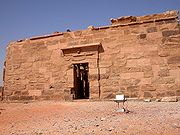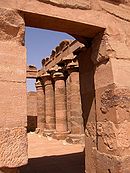
Temple of Maharraqa
Encyclopedia

30 BC
Year 30 BC was either a common year starting on Wednesday, Thursday or Friday or a leap year starting on Thursday of the Julian calendar and a common year starting on Wednesday of the Proleptic Julian calendar...
, the Kushites from the kingdom of Meroë
Meroë
Meroë Meroitic: Medewi or Bedewi; Arabic: and Meruwi) is an ancient city on the east bank of the Nile about 6 km north-east of the Kabushiya station near Shendi, Sudan, approximately 200 km north-east of Khartoum. Near the site are a group of villages called Bagrawiyah...
launched a raid on the First cataract region of Egypt in 23 BC. The Roman prefect of Egypt, Petronius, retaliated and defeated the invading Meroitic army. He then proceeded to station a Roman garrison of 400 troops at the southern outpost of Qasr Ibrim
Qasr Ibrim
Qasr Ibrim is an archaeological site in Lower Nubia. It was originally a major city perched on a cliff above the Nile, but the flooding of Lake Nasser after the construction of the Aswan High Dam transformed it into an island and flooded its outskirts. Qasr Ibrim is the only major archaeological...
. After some negotiations, a permanent frontier between Meroë and Roman Egypt was established at Maharraqa. Thus, Maharraqa formed the extreme southern frontier of Roman Egypt.
The Serapis Isis Temple of Maharraqa


Aswan Dam
The Aswan Dam is an embankment dam situated across the Nile River in Aswan, Egypt. Since the 1950s, the name commonly refers to the High Dam, which is larger and newer than the Aswan Low Dam, which was first completed in 1902...
project. It was dedicated to the Egyptian gods Isis
Isis
Isis or in original more likely Aset is a goddess in Ancient Egyptian religious beliefs, whose worship spread throughout the Greco-Roman world. She was worshipped as the ideal mother and wife as well as the matron of nature and magic...
and Serapis
Serapis
Serapis or Sarapis is a Graeco-Egyptian name of God. Serapis was devised during the 3rd century BC on the orders of Ptolemy I of Egypt as a means to unify the Greeks and Egyptians in his realm. The god was depicted as Greek in appearance, but with Egyptian trappings, and combined iconography...
. This Roman-built Egyptian temple
Egyptian temple
Egyptian temples were built for the official worship of the gods and commemoration of pharaohs in Ancient Egypt and in regions under Egyptian control. These temples were seen as houses for the gods or kings to whom they were dedicated...
cannot be securely attributed to any Roman emperor's reign since it was never fully completed nor inscribed. However, since it is known that temple building declined in Nubia after the rule of Augustus
Augustus
Augustus ;23 September 63 BC – 19 August AD 14) is considered the first emperor of the Roman Empire, which he ruled alone from 27 BC until his death in 14 AD.The dates of his rule are contemporary dates; Augustus lived under two calendars, the Roman Republican until 45 BC, and the Julian...
, the temple of Maharraqa might be datable to his reign. The only part of the structure that was finished "was a court measuring 13.56 X 15.69 m, which was surrounded on three sides by columns." The actual temple premises containing the sanctuary was never actually built. The temple, as well, lacks a formal pylon
Pylon (architecture)
Pylon is the Greek term for a monumental gateway of an Egyptian temple It consists of two tapering towers, each surmounted by a cornice, joined by a less elevated section which enclosed the entrance between them. The entrance was generally about half the height of the towers...
.
The Temple of Maharraqa features an architectural curiosity with a winding spiral staircase at a corner of the court, which led to its roof. This is the only Egyptian temple in Nubia with a spiral staircase.
Relocation of the Temple
Since its former location was threatened by flooding from the Nile due to the construction of the Aswan dam, this small temple was dismantled in 1961 by the Egyptian Antiquities Service. It was subsequently rebuilt along with the Temple of DakkaTemple of Dakka
Ad-Dakka was a place in Lower Nubia, which was located approximately 100 km south of the Aswan...
in 1966 at the New Wadi es-Sebua
New Wadi es-Sebua
The site of New Wadi es-Sabua, which is located only 4 km west from the original site of Wadi es-Sebua, is today home to three Ancient Egyptian temples in Lower Nubia, the temples of Wadi-es Sebua, Maharraqa and Dakka respectively.-Wadi es-Sabua Temple:...
site which lies only 4 km west of the original Wadi es-Sebua location. As Christine Hobson notes:
"A little to the north of Amada
Amada
The Temple of Amada, the oldest Egyptian temple in Nubia, was first constructed by pharaoh Thutmose III of the 18th dynasty and dedicated to Amun and Re-Horakhty. His son and successor, Amenhotep II continued the decoration program for this structure. Amenhotep II's successor, Thutmose IV decided...
now stand the temples of Wadi es Sebua
Wadi es-Sebua
Wadi es-Sebua, or Valley of the Lions , is the site of two New Kingdom Egyptian temples, including one impressively large temple spéos of Ramesses II, at the edge of Nasser lake in Lower Nubia. The first temple was built by Amenhotep III and subsequently restored by Ramesses II...
(built by Ramesses II), Dakka and Maharraka."

